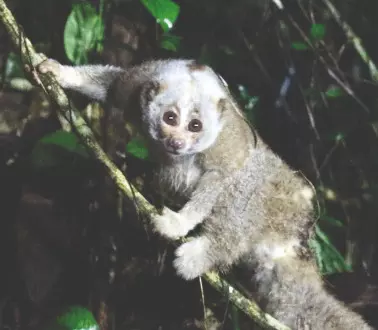Study probes Bengal Slow Loris decline & dispersal

Kolkata: A new study on the Bengal Slow Loris (Nycticebus bengalensis) has assessed its habitat and connectivity under different future climate scenarios and proposed a hypothesis on its dispersal within Southeast Asia during the Pleistocene. The study assumes significance as currently the species is listed as ‘endangered’ on the IUCN Red List of Threatened Species, with more than 50 per cent of its population having declined over the past three generations.
The study has been made possible through a collaboration between the Dibru-Saikhowa Conservation Society, Assam, India and Pukyong National University, Busan, South Korea.
The Bengal Slow Loris is a nocturnal, arboreal and slow-moving primate native to South and Southeast Asia. Among the nine species within the genus Nycticebus, it has the broadest geographical range.
“We used ensemble species distribution models and circuit models to identify their environmental envelope and climatic refugia under future scenarios and also presented possible dispersal pathways and corridors. The findings are alarming, as only 32.61 per cent and 21.88 per cent of the current habitat remain suitable within the extended training range and within forest cover, respectively.
The future projections indicate a substantial decline exceeding 85.62 (extended training range) and 83.76 per cent (within forest cover) accompanied by severe habitat fragmentation and loss of connectivity,” said Imon Abedin.
“We also identified different transboundary corridors and analysed their shifts under future scenarios. However, all identified corridors are expected to undergo a significant decline in mean connectivity under future climate conditions, largely driven by the adverse effects of climate change,” said Prof Hyun-Woo Kim.
The scientists have called for urgent and coordinated conservation efforts to safeguard the Bengal Slow Loris across South and Southeast Asia. They have recommended expanding protected areas to include evergreen forests critical to the species and enforcing stricter measures against deforestation, hunting and illegal wildlife trade.
“Regulating pesticide use near loris habitats is essential to prevent contamination of their invertebrate prey. We also emphasise the need to curb agricultural expansion, particularly palm oil cultivation. The construction of canopy bridges or wildlife overpasses is crucial to connect fragmented forests and reduce roadkill incidents.
Furthermore, we strongly advocate for the establishment of a joint national and transboundary conservation committee comprising governments, NGOs and
international organisations such as the IUCN to coordinate conservation actions, monitor wildlife markets and raise community awareness. Finally, we recommend conducting genetic and population studies to assess diversity among isolated populations and to inform species-specific management strategies,” said Prof Shantanu Kundu.
The study has been published in the Springer Nature Q1 ranked journal Biodiversity and Conservation.



